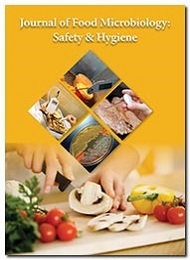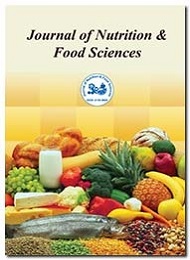Theme: Changing the World by Exploring the Modern Methods and Techniques in Food Industry
Food Manufacturing 2022
We cordially invite participants from all over the world to attend the 14th International Conference on Food Technology and Processing slated on November 22-23, 2022 in webinar with the theme of "Changing the World by Exploring the Modern Methods and Techniques in Food Industry". The main goal of the Food Manufacturing 2022 meeting is to accelerate the translation of leading-edge discoveries and to promote scientific collaboration, exchange, and fellowship among the Food industry colleagues and professionals.
Through this Food Manufacturing 2022, we bring food laureates, food scientists, researchers, entrepreneurs, investors, chefs, executives, technologists, nutritionists, dieticians, academicians, chemists, journalists and business associates to share their best practices and explore the innovation in Food Technology. Improvements in the food and agriculture sectors are essential to achieve these goals and thus improve human and Environmental health.
It’s our great pleasure to announce "14th International Conference on Food Technology and Processing” during November 22-23, 2022 as a webinar with the theme of Changing the World by Exploring the Modern Methods and Techniques in Food Industry".
On behalf of organizing committee we take great pleasure to invite participants from all over the world to attend 14th International Conference on Food Technology and Processing” during November 22-23, 2022 as a webinar. Food manufacturing conference aims to bring together the prominent researchers, academic scientists, and research scholars to exchange and share their experiences in all aspects of Food Technology and Processing.
Track 1: Food Technology
It is a science branch mainly deals with the techniques involved in production, preservation, processing, packaging, quality management, labelling and distribution of food products. Extensive research goes behind making food items edible and also nutritious. The main study of food technology is to develop new systems and methods for keeping food products safe and resistant against micro-organisms and bacteria. Food processing helps in preservation increases the flavor and reduces the toxins in the food product which results in better distributional efficiency and easy marketing of the food product.
-
Food Processing
-
Food Plant Layout & Design
-
Scope of Food Technology
-
Food Laws and Quality Assurance
Related Associations and Societies: Association of Food Science and Technology of Basque Country | Belgian Association of Food Technology | Central Food Research Institute | Centre for Advanced Food Studies | Czech Committee for Food Science and Technology | Food research Institute Albania | German Federation of Food Science and Technology | National Institute for Agriculture Research in Tunis
Track 2: Food Engineering and Processing
Food engineering and processing is a multidisciplinary field that explicate and applies principles of science, engineering and mathematics to food manufacturing and operations, including the production, processing, handling, storage, conservation, control, packaging and also distribution of food products. It is a wide range of field includes an extensive variety of exercises, for example, sustenance handling, bundling, nourishment hardware, fixing assembling, instrumentation, and control. It also includes the idea of comprehension of thermodynamics, response energy, and transport wonders connected to nourishment forms. Additionally it is also used to utilize present day devices, innovation, and learning, for example, nanotechnology and computational materials science for development of new products and procedures. New bundling materials and procedures are being created to give more affirmation to nourishments, and novel safeguarding innovation is developing.
-
Energy for food processing
-
Heat transfer in food processing
-
Food Safety Management Systems
-
Agricultural Engineering
-
Sanitation Technologies
-
Chemical Engineering
Related Associations and Societies : European Hygienic Engineering and Design Group | European Federation of Food and Nutrition | European Food and Nutrition Information Resource Network | European Food Information Council | University of Massachusetts Amherst | National Frozen Food Association | Institute of Food Technologists | International Association of Food Industry Suppliers | International Bottled Water Association | Asian Food Safety and Security Association
Track 3: Food Safety, Food Security and Food fraud
Food safety refers to routines within the preparation, handling and storage of food meant to prevent foodborne illness and injury. From farm to Manufacturing plant to fork, food products may face no.of health hazards during their journey through the supply chain. Safe food handling practices and procedures ought to be enforced at each stage of the food production life cycle so as to decrease to decrease the risks and prevent harm to consumers. Food Security, is that the condition within which all the individuals, in any respect times, have social, Physical and conjointly economic access to safe and nourishing food to satisfy their nutrition wants and food preferences for an energetic and healthy life. When a food supplier deliberately mislead its customer about the quality and contents of the foods they are purchasing. While food fraud is often influence by profit, some forms of food fraud is a direct threat to the health of customers and consumers.
-
Global Food Security
-
Food Safety and Public Health
-
Risks to Food Security
-
Liberalization and Transitory Food Insecurity
Related Associations and Societies : European Food Safety Authority | Spanish Council for Scientific Research | Institute of Food Science and Technology of Ireland | Department for Environment Food and Rural Affairs | Food Standards Agency | Food research Institute Albania | German Federation of Food Science and Technology | National Institute for Agriculture Research in Tunis
Track 4: Food Manufacturing
In the Food manufacturing subsector Industries convert livestock and agricultural products into products for intermediate use or final consumption. The industry groups are distinguished by the raw materials (generally of animal or vegetable origin processed into food products. One of the most important challenges for food manufacturers is to make sure the safety of their products. By nature, food is very exposed to deterioration, namely caused by the more no.of raw materials and ingredients sourced from a diverse array of suppliers in combination with global and complex supply chains. The release of unsafe food to the market can show the impact on public health, results in loss of consumer confidence and damaged brand reputation.
-
Machine Maintenance
-
Prioritize Sanitation
-
Additional Quality Checks
-
Antimicrobial Resistance
Related Associations and Societies : International Association of Food Industry Suppliers | European Federation of Food and Nutrition | European Food and Nutrition Information Resource Network | European Hygienic Engineering and Design Group | European Food Information Council | University of Massachusetts Amherst | National Frozen Food Association | Institute of Food Technologists
Track 5: Food Processing Hygiene
Hygiene control in factories which manufacture or process food is the adoption of practices which will reduce the risk of clean food becoming contaminated. The aim of hygiene control is to stop the spread of bacteria and other microorganisms. Hygiene and safety of food starts right from selecting raw material carefully, preparing food with health and safety cautiousness, and serving it within the clean environment. The service staff must attend duty in clean and tidy uniform. The four basic food safety principles:
-
Clean
-
Separate
-
Chill
-
Cook
These principles directly align with the Academy of Nutrition and Dietetics four easy tips to reduce the risk of food poisoning.
-
Food Sanitation
-
Nutrition and Food safety
-
Dairy and Poultry Food Hygiene
-
Food Contamination
Related Associations and Societies : European Food Safety Authority | Spanish Council for Scientific Research | Institute of Food Science and Technology of Ireland | Department for Environment, Food and Rural Affairs | Food Standards Agency | Food research Institute Albania | German Federation of Food Science and Technology | National Institute for Agriculture Research in Tunis
Track 6: Food Chemistry
This food chemistry mainly deals with the functional and structural characterization of minor and major food components. Food chemistry is a study of kinetics of enzymes to enhance the food quality, nutritional and safety content. The major important thing is that to know about the physical and also fundamental changes in food. Chemistry also involve in our daily day lifelike of digestion depends on chemical reactions between food and acids to break enzymes and convert it into the energy
-
Chemical analysis of food
-
Food additives
-
Food science and food meat biochemistry
-
Food coloring agents
Related Associations and Societies : International Bottled Water Association | Asian Food Safety and Security Association | Food Industry Students European Council | Association Zoonotic Food borne Pathogens | International Association Engineering & Food | International Association Food Protection | International Food & Agribusiness Management Association | Korean Society Food Science & Technology
Track 7:Food Microbiology
Food microbiology is the study of micro-organisms which includes food contamination as well as used in Food production. Microorganisms can preserve food through formation of inhibitory metabolites such as organic acids, this microbial food cultures used in fermentation like yeast, bacteria, and moulds. Now a days many studies dealing with health-promoting benefits associated with the consumption of fermented foods and beverages have been proposed. Temperature plays vital role in controlling the microbial growth. To ensure food safety some microbial tests are also being done for pathogen and spoilage microorganisms is required.
-
Industrial Microbiology
-
Food Mycology
-
Predictive Microbiology
-
Microbial aspects of food spoilage and quality
-
Industrial Microbiology
-
Nutritional availability in foods
Related Associations and Societies : International Union of Microbiological Societies (IUMS) | American Association Nutritional Consultants | American Nutrition Association | Association Coordination & Research in Obesity & Nutrition | Association Nutrition Departments & Programs (ANDP) | Belgium Association Nutritionists & Dieticians | British Association Nutritional Therapists (BANT) | Commonwealth Association paediatric Gastroenterology & Nutrition (CAPGAN) | Diet & Nutrition Association
Track 8: Food Nutrition and Dietetics
Food Nutrition and dietetics helps people to improve their health. The food we eat has a important impact on our health, according to a number of scientific studies. Changes in diet can also help in prevention or control many health problems; including diabetes, obesity and certain risk factors for cancer and heart disease. Dietetics is the science of how food and nutrition affects our human health. The field of dietetics has a strong prominence on public health.
-
Basic Nutrition
-
Malnutrition
-
Clinical Nutrition
-
Dietary Supplements
-
Nutrition by Age
Related Associations and Societies : European Association Gastroenterology, Endoscopy & Nutrition| European Society Clinical Nutrition & Metabolism| European Society Paediatric Gastroenterology, Herpetology & Nutrition | Federation African Nutrition Societies | Federation Asian Nutrition Societies | Federal Ministry of Food, Agriculture and Consumer Protection | ISEKI Food Association | Institute of Food Research
Track 9: Food Toxicology
Food toxicology is main study of the nature, properties, effects and detection of toxic substances in food and their disease demonstration in humans. Radioactive elements, heavy metals, or the packing materials used in food processing are examples of such toxic substances. By means of molecular and cell biology, modern biochemistry, computer science, bioinformatics as well as high-throughput and high-content screening technologies we can identify adverse effects and characterize potential toxicants in food
-
Food Allergy
-
Food Intolerance
-
Genetically Modified Food
Related Associations and Societies : International Union of Microbiological Societies (IUMS) | American Association Nutritional Consultants | American Nutrition Association | Association Coordination & Research in Obesity & Nutrition | Association Nutrition Departments & Programs (ANDP) | Belgium Association Nutritionists & Dieticians | British Association Nutritional Therapists (BANT) | Commonwealth Association paediatric Gastroenterology & Nutrition (CAPGAN) | Diet & Nutrition Association
Track 10: Food-borne Diseases
Foodborne diseases are mainly caused by contamination of food and occur at any step of the food production, delivery and also during consumption. Food borne illness can also be occurred by environmental contamination including pollution in soil or air, pollution in water, as well as unsafe f storage of food. Foodborne diseases enclose a wide range of illnesses from diarrhoea to cancer. Raw foods of animal origin, that mostly includes raw meat and poultry, unpasteurized milk, raw eggs, and raw shellfish are the most likely to be contaminated. Most Commonly recognized food borne pathogens are Camplyobacteriosis, crypto sporidiumgiardia, shigella and salmonella. Some of the causes are unhygienic practices in food harvesting, production and preparation. To avoid contamination you must be clean your hands always, before touching any food.
-
Food Poisoning
-
Hazard Recognition
-
Control and Prevention Food-borne Diseases
Related Associations and Societies : Association of Food Science and Technology of Basque Country, Spain | Belgian Association of Food Technology | Central Food Research Institute, India | Centre for Advanced Food Studies | Czech Committee for Food Science and Technology, Czech Republic |Food research Institute Albania | German Federation of Food Science and Technology | National Institute for Agriculture Research in Tunis
Track 11: Management of Food Waste
Food waste and loss is the major problem in our modern society. Food-scrap recycling has many benefits. Food scraps can be used in composting, which enhance soil and reduces emissions of methane (a potent greenhouse gas) from landfills. It also reduces the volume of landfill needed in a given area. At the post-harvest stage and processing stage, there is a waste in each step of the transport, processing, storage and distribution stages. Hence the food waste management has become a top most priority, by seeing these all the activities related to avoiding, reducing or recycling waste throughout the production and consumption chain Food Waste Management strategies includes Prevent and reduce food wastage at source, Redistribute unsold/excess food, Recycle/Treat food waste, Recover energy.
-
Organic Recycling of Food
-
Strategies and Technologies to Reduce Food Wastage
-
Design, and Implement a Food Recycling Process
Related Associations and Societies: European Hygienic Engineering and Design Group | European Federation of Food and Nutrition | European Food and Nutrition Information Resource Network | European Food Information Council | University of Massachusetts Amherst | National Frozen Food Association | Institute of Food Technologists | International Association of Food Industry Suppliers | International Bottled Water Association | Asian Food Safety and Security Association
Track 12: Food Nanotechnology
Nanotechnology is now playing a crucial role in the food industry and establishing great potential. Nanomaterials are widely used in the food packaging industry due to the range of advanced functional properties they can bring to packaging materials. Nanotechnology-enabled food packaging can also be divided into three main types - active packaging, improved packaging and intelligent/smart packaging. Clay Nanoparticles are being used to Improve Plastic Packaging for Food Products; We can use Food Packaging Sensors in Defence and Security Applications. In food industry, nanotechnology has been used in order to increase the delivery of food ingredients to inhibit bacterial growth, increase flavour, target sites, extend product shelf life and also improve food safety.
-
Nano coating
-
Nano sized chemicals
-
Nano encapsulation
-
Bio-synthesized nanomaterial
-
Bio-inspired nanomaterial
Related Associations and Societies : International Association of Food Industry Suppliers | European Federation of Food and Nutrition | European Food and Nutrition Information Resource Network | European Hygienic Engineering and Design Group | European Food Information Council | University of Massachusetts Amherst | National Frozen Food Association | Institute of Food Technologists
Track 13: Food Allergy and Public Health
Food allergies have a significant impact on Public Health. Food allergies mainly develop when a person consumes or comes in contact with their allergen, and our immune system makes an antibody called immunoglobulin E. It circulates through the blood and attaches to immune cells called mast cells and basophils. This initial exposure does not cause an allergic reaction, however subsequent contact with the same allergen again may allow previously created IgE antibodies to recognize it. This identification then begin an immune response that can result in a severe allergic reaction in our body. So to avoid these types of reactions there should be more specific labeling requirements.
-
Anaphylaxis
-
Diagnosing a Food Allergy
-
Maintaining a Healthy Lifestyle
-
Medications and Vaccines
Related Associations and Societies : International Bottled Water Association | Asian Food Safety and Security Association | Food Industry Students European Council | Association Zoonotic Food borne Pathogens | International Association Engineering & Food | International Association Food Protection | International Food & Agribusiness Management Association | Korean Society Food Science & Technology
Track 14: Food Education
Food Education is necessary to increase knowledge and the ability to make choices concerning nutrition & health and food & food quality. Nutrition education can mainly influence the view of food choices and eating habits. It can inspire the people about importance of fruits and vegetables and non-processed foods. It may even shape their perspective of health and wellness for the rest of their life as we know Health begins at home and it is emphasized at school. The four basic components were health, nutrition, Environment and food. Clinicians and educators that are aiming to reorient health programming and take it to the next level and without knowing how food is grown or cultivated, we will never understand how it impacts our health and wellness.
-
Food Education Management
-
Innovations in Food Education
-
Food Authenticity and Integrity
-
Food Safety Surveillance System
Related Associations and Societies : European Association Gastroenterology, Endoscopy & Nutrition | European Society Clinical Nutrition & Metabolism | European Society Paediatric Gastroenterology, Herpetology & Nutrition | Federation African Nutrition Societies | Federation Asian Nutrition Societies | Federal Ministry of Food, Agriculture and Consumer Protection | ISEKI Food Association | Institute of Food Research
The global market for machinery and equipment used in the Food manufacturing process involves the production of completed food products from raw ingredients, with processing lengthening the shelf life of products and adhering to good hygiene and health standards.
The global food technology market size was USO 220.32 Bill on in 2019, and it is expected to reach USO 342.52 Billion by 2027, at a CAGR of 6.0% during the forecast period. Within the food industry the market is primarily driven by the growth of advanced technologies. By increasing utilization of advanced technologies in food processing techniques is driving the growth of the food technology industry. Innovations in robotics, data technology and processing techniques, are creating new growth opportunities in the food industry. By increasing awareness among the health-conscious population is increasing the demand for healthier foods. Rising demand for cheaper, healthier and safer food products is driving the market for food tech.
Growth of the ecommerce channels is mainly due to the convenience of discounts and cash-on-delivery is majorly contributing to the growth of the market for food technology. Moreover, the increasing perforation of the internet and smartphones in developing economies is supporting the development of the market during the forecast period and also increasing demand for quick and suitable food and grocery delivery is boosting the growth of the food technology market. In the future, factors such as demand for more and good quality products, reduced availability of staff and higher wage costs, and the reducing cost of technology are expected to tonic the advancements of the market for food technology.
The Market report covers exhaustive analysis on: Global Food Technology Market Segments, Global Food Technology Market Dynamics, Historical Actual Market Size, 2013-2017, Global Food Technology Market Size & Forecast 2017 to 2028, Supply & Demand Value Chain for Food Technology Market, Global Food Technology Market Current Trends/Issues/Challenges, Competition & Companies involved in Food Technology Market, Food Technology Technologies, Value Chain of Food Technology, Global Food Technology Market Drivers and Restraints
Conference Highlights
- Food Technology
- Food Engineering and Processing
- Food Safety, Food Security and Food Fraud
- Food Manufacturing
- Food Processing Hygiene
- Food Chemistry
- Food Microbiology
- Food Nutrition and Dietetics
- Food Toxicology
- Food-borne Diseases
- Management of Food Waste
- Food Nanotechnology
- Food Allergy and Public Health
- Food Education
To share your views and research, please click here to register for the Conference.
To Collaborate Scientific Professionals around the World
| Conference Date | November 22-23, 2022 | ||
| Sponsors & Exhibitors |
|
||
| Speaker Opportunity Closed | Day 1 | ||
| Poster Opportunity Closed | Click Here to View | ||
Useful Links
Special Issues
All accepted abstracts will be published in respective Our International Journals.
- Journal of Food: Microbiology, Safety & Hygiene
- Journal of Nutrition & Food Sciences
- Journal of Agricultural Science and Food Research
Abstracts will be provided with Digital Object Identifier by











